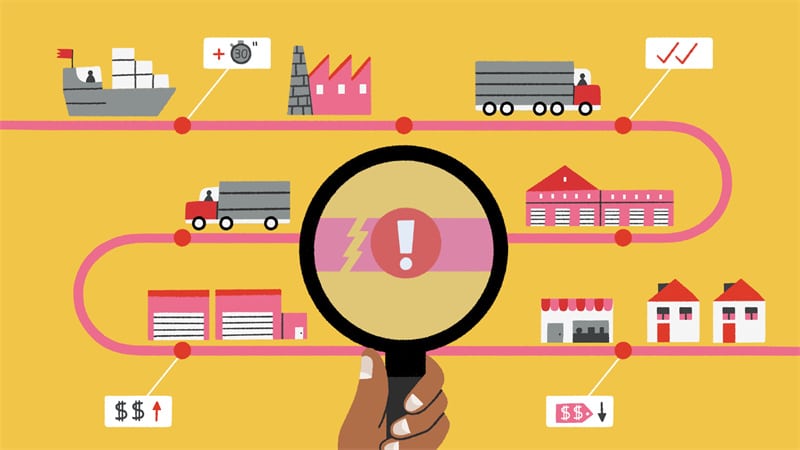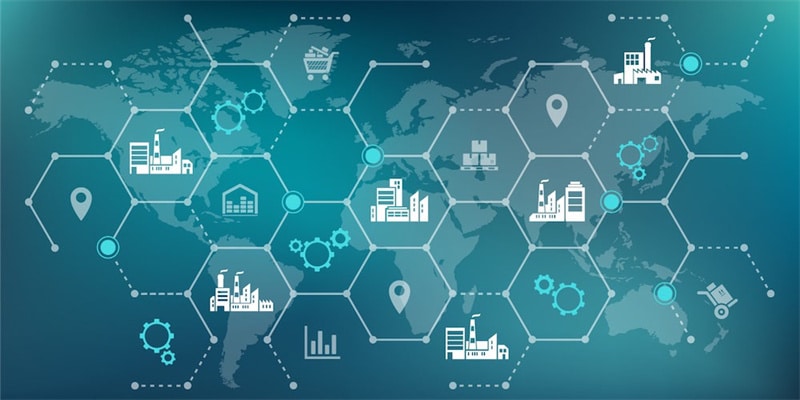
The supply chain is the backbone of modern businesses, encompassing the complex network of activities involved in the production, transportation, warehousing, and distribution of goods and services.
Over the years, the management of supply chains has evolved significantly, driven by advancements in technology, changing customer expectations, and the need for increased efficiency and competitiveness. One of the key drivers of this evolution has been the development of supply chain software, which has revolutionized the way businesses manage their supply chains.
Supply chain software development has come a long way from the traditional manual methods of managing supply chains. Today, supply chain software encompasses a wide range of technologies, including enterprise resource planning (ERP) systems, transportation management systems (TMS), warehouse management systems (WMS), demand planning software, inventory optimization tools, and many more.
These software solutions enable businesses to gain real-time visibility, optimize operations, improve collaboration, and make data-driven decisions to enhance their supply chain performance.
In this article, we will explore the evolution of supply chain software development and how it has transformed the way businesses manage their supply chains.
Early Days of Supply Chain Software

The early days of supply chain software were characterized by basic functionality and limited integration. The focus was primarily on automating manual processes, such as order entry, inventory tracking, and basic forecasting. These early software solutions were often standalone systems that were not fully integrated with other business functions, resulting in limited visibility and coordination across the supply chain.
However, these early supply chain software solutions laid the foundation for the development of more advanced and integrated solutions in the future. As businesses recognized the value of automating supply chain processes, the demand for more sophisticated and comprehensive supply chain software grew.
Rise of Enterprise Resource Planning (ERP)
The advent of enterprise resource planning (ERP) systems in the 1990s revolutionized supply chain management. ERP systems integrated various business functions, including supply chain management, finance, human resources, and sales, into a single, unified platform. This enabled businesses to gain end-to-end visibility and control over their supply chains, from procurement to production to distribution.
ERP systems provided businesses with the ability to automate and optimize supply chain processes, such as demand planning, inventory management, and order fulfillment. These systems also enabled better collaboration and communication across the supply chain, as all functions were integrated and had access to a single source of truth for data.
Emergence of Specialized Supply Chain Software
As supply chains became more complex and global, businesses realized the need for specialized supply chain software that could address specific needs and challenges. This led to the emergence of specialized supply chain software solutions that focused on specific functions, such as transportation management, warehouse management, and demand planning.
These specialized supply chain software solutions provided businesses with more advanced functionality and capabilities in specific areas of the supply chain. For example, transportation management systems (TMS) enabled businesses to optimize transportation routes, reduce freight costs, and enhance carrier collaboration.
Warehouse management systems (WMS) provided advanced inventory management, order picking, and packing capabilities, improving warehouse efficiency and reducing operational costs.
Advancements in Technology
The Era of Advanced Analytics, Automation, and IoT With advancements in technology, supply chain software has evolved further to incorporate advanced analytics, automation, and the Internet of Things (IoT). These technologies have revolutionized the way businesses manage their supply chains, providing unprecedented levels of visibility, efficiency, and agility.
Advanced analytics has enabled businesses to analyze vast amounts of data from various sources, such as sales, production, transportation, and weather, to gain insights and make data-driven decisions. Predictive analytics and machine learning algorithms have allowed businesses to forecast demand more accurately, optimize inventory levels, and identify potential supply chain disruptions in advance.
Automation has also played a significant role in transforming supply chain management. Robotic process automation (RPA) has been utilized to streamline manual and repetitive tasks, such as order processing, invoice verification, and shipment tracking, leading to increased efficiency and reduced errors. Automated guided vehicles (AGVs) and drones have been deployed in warehouses and distribution centers to automate material handling and transportation, improving operational speed and accuracy.
The Internet of Things (IoT) has also emerged as a game-changer in supply chain management. IoT devices, such as sensors, trackers, and smart devices, can collect and transmit real-time data on various aspects of the supply chain, including inventory levels, shipment status, and transportation conditions. This data can be analyzed to gain insights, optimize operations, and improve decision-making.
For example, temperature sensors in refrigerated trucks can monitor the condition of perishable goods, ensuring that they are transported under the right conditions to maintain their quality and freshness.
Cloud-Based Supply Chain Software

Another significant advancement in supply chain software development has been the adoption of cloud-based solutions. Cloud-based supply chain software offers several benefits, including enhanced collaboration, scalability, and cost-efficiency.
Cloud-based supply chain software allows businesses to access and share data across the supply chain in real-time, facilitating better collaboration and communication. Suppliers, manufacturers, logistics providers, and customers can all access and update information through a centralized platform, reducing delays, errors, and miscommunications.
Cloud-based supply chain software also offers scalability, as businesses can easily adjust their usage and storage requirements based on their needs. This eliminates the need for expensive hardware and infrastructure investments and allows businesses to scale their supply chain operations up or down as needed, making it ideal for small and medium-sized enterprises (SMEs) as well.
Integration of Supply Chain Software with Emerging Technologies
As technology continues to advance, supply chain software is expected to further evolve by integrating with emerging technologies such as artificial intelligence (AI), blockchain, and big data analytics.
AI has the potential to revolutionize supply chain management by automating decision-making, optimizing operations, and predicting disruptions. For example, AI algorithms can analyze large amounts of data, such as historical sales data, weather patterns, and transportation data, to optimize inventory levels, transportation routes, and production schedules.
AI can also analyze real-time data from IoT devices to detect anomalies and predict potential disruptions in the supply chain, allowing businesses to take proactive measures to mitigate risks.
Blockchain technology has the potential to enhance supply chain transparency, traceability, and security. By creating a decentralized and immutable ledger of transactions, blockchain can enable end-to-end visibility and traceability of goods, reducing the risk of counterfeit products, improving trust among supply chain partners, and ensuring compliance with regulations and standards.
Big data analytics can provide businesses with deeper insights into their supply chain operations by analyzing large and complex data sets. For example, analyzing data from multiple sources, such as sales data, transportation data, weather data, and social media data, can help businesses identify patterns, trends, and opportunities to optimize their supply chain performance.
Future Trends in Supply Chain Software Development
The future of supply chain software development is expected to be shaped by several key trends that will further transform the way businesses manage their supply chains.
- Sustainability and ESG (Environmental, Social, and Governance) considerations are expected to play a more significant role in supply chain management. Supply chain software is expected to incorporate functionalities to track and optimize sustainability metrics, such as carbon emissions, waste reduction, and ethical sourcing, to meet growing consumer and regulatory demands for sustainable and responsible supply chains.
- Enhanced visibility and transparency will become crucial in supply chain management. Businesses will increasingly adopt technologies like IoT, blockchain, and AI to gain real-time visibility into their supply chains, enabling them to track and trace products, monitor environmental conditions, and optimize logistics operations.
- Supply chain risk management will become a top priority. The increasing frequency and severity of supply chain disruptions, such as natural disasters, geopolitical tensions, and pandemics, have highlighted the need for robust risk management strategies. Supply chain software will incorporate advanced analytics and predictive algorithms to identify potential risks and enable proactive risk mitigation measures.
- Collaboration and partnership will be emphasized. Supply chain software will facilitate greater collaboration and partnership among supply chain partners, including suppliers, manufacturers, logistics providers, and customers. Collaborative platforms will enable real-time data sharing, collaborative decision-making, and streamlined communication, leading to more efficient and resilient supply chains.
- Automation and robotics will continue to advance. As technology evolves, automation and robotics will continue to play a significant role in supply chain operations. Advanced robotics, including autonomous vehicles, drones, and robotic process automation (RPA), will further streamline supply chain processes, reduce costs, and improve operational efficiency.
- Advanced analytics and AI will drive data-driven decision-making. The increasing availability of data from various sources, such as IoT devices, social media, and external market data, will drive the adoption of advanced analytics and AI in supply chain management. Businesses will leverage these technologies to gain actionable insights, optimize operations, and make data-driven decisions to enhance their supply chain performance.
- Personalization and customer-centricity will become key drivers. With the rise of e-commerce and changing consumer preferences, personalization and customer-centricity will be critical in supply chain management. Supply chain software will enable businesses to meet individual customer demands by offering personalized products, services, and experiences, leading to increased customer satisfaction and loyalty.
- Cybersecurity will be a top concern. As supply chains become more digitized and interconnected, cybersecurity threats will continue to be a significant concern. Supply chain software will incorporate robust cybersecurity measures, including encryption, authentication, and threat detection, to protect sensitive supply chain data and ensure the integrity and confidentiality of information.
Conclusion
Supply chain software development has come a long way, revolutionizing the way businesses manage their supply chains. From basic inventory management systems to sophisticated cloud-based solutions with advanced analytics, automation, and integration with emerging technologies, supply chain software has enabled businesses to achieve greater efficiency, visibility, and resilience in their supply chain operations.
The future of supply chain software development is expected to be driven by sustainability, visibility, collaboration, automation, advanced analytics, customer-centricity, cybersecurity, and risk management. As businesses continue to face evolving challenges and opportunities in the global supply chain landscape, supply chain software will continue to play a crucial role in driving innovation and enabling businesses to stay competitive in the ever-changing business environment.










